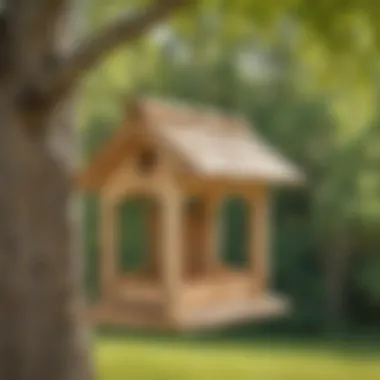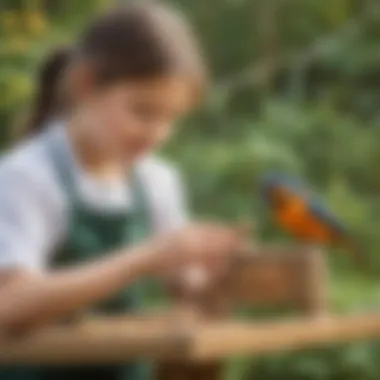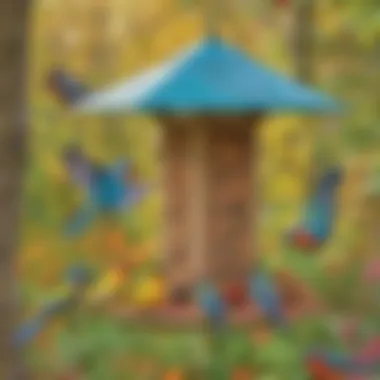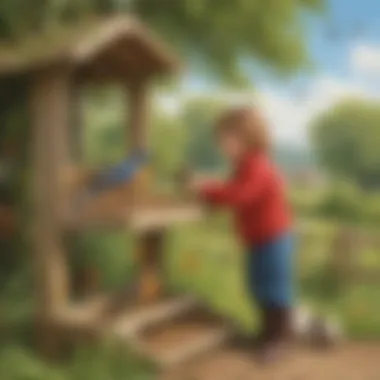Engage Young Minds: Crafting an Easy Bird Feeder for Science Enthusiasts


Science Fun Facts
In the world of nature, birds play an essential role. They help control insect populations, distribute seeds, and even pollinate plants. Did you know that some birds can travel thousands of kilometers during migration, guided by Earth's magnetic field? It's fascinating how these feathered creatures navigate across vast distances with such precision.
Birds have unique beaks adapted to their feeding habits. For example, woodpeckers have strong, chisel-like beaks for drilling into wood to find insects, while hummingbirds have long, slender beaks to reach nectar deep within flowers. The variety in beak shapes and sizes showcases the diverse ways birds have evolved to survive in their environments.
Observing birds in your backyard can uncover a whole world of wonders. From identifying different species based on their calls to understanding their distinctive behaviors, every moment spent bird-watching offers an opportunity to learn and appreciate the beauty of nature.
Birds are not just skilled fliers but also remarkable architects. Some species build intricate nests using materials like twigs, mud, and even spider silk. Each nest is a work of art, demonstrating the bird's ingenuity and resourcefulness in creating a safe space to raise their young.
Discover the Wonders of Science
Crafting a bird feeder isn't just a creative project; it's also an opportunity to explore scientific concepts in action. By observing birds interact with the feeder, young enthusiasts can learn about animal behaviors, ecological relationships, and even concepts like gravity and balance.
Educational videos and animations can further enhance the learning experience. Watching informative clips on bird anatomy, feeding habits, and migration patterns can deepen children's understanding of these fascinating creatures. Interactive tools that simulate bird feeding behavior can also provide hands-on learning opportunities.
Real-life applications of science come to life through bird-watching. Understanding the principles of ecosystems, food chains, and biodiversity becomes tangible when observing birds in their natural habitat. Each bird feeder becomes a mini science experiment, attracting different species and showcasing real-world scientific phenomena.
Science Quiz Time
To engage young minds and reinforce learning, incorporating fun quizzes and brain teasers can be both entertaining and educational. By quizzing children on bird identification, feeding preferences, or nesting habits, parents and caregivers can encourage curiosity and critical thinking.
Multiple-choice questions can test children's knowledge of ornithology, biology, and environmental science. Brain teasers related to bird behaviors or adaptations can challenge young enthusiasts to think creatively and analytically. Turning learning into a game can make scientific concepts more accessible and enjoyable.
Gamification adds an element of excitement to the learning process. By transforming scientific facts into interactive puzzles or challenges, children can engage with the material in a stimulating and rewarding way. Learning about birds can become a dynamic, hands-on experience that sparks a lifelong interest in science.
Science Experiment Showcase
A hands-on science experiment involving bird feeders can bring theoretical learning to practical application. By following step-by-step instructions, children can create their own feeder using simple materials like cardboard, string, and birdseed. This activity not only fosters creativity but also teaches important skills like measurement, fine motor coordination, and following directions.
Creating a materials list helps children understand the components needed for the project, emphasizing the importance of preparation and organization in scientific endeavors. Including safety tips and precautions ensures that young scientists can delve into the experiment with caution and responsibility, promoting a culture of safe experimentation.


As children watch birds visit the feeder they've crafted, they witness the direct impact of their actions on the natural world. This hands-on experience not only cultivates empathy and environmental awareness but also instills a sense of accomplishment and stewardship. Crafting a bird feeder transcends a mere DIY project; it becomes a lesson in curiosity, discovery, and the interconnectedness of life.
Introduction Introduction
Bird-watching and appreciating wildlife can be both relaxing and educational for young science enthusiasts. Craftings an Easy Bird Feeder for Young Science Enthusiasts merges creative DIY activities with the opportunity to observe and learn about local bird species. This practical project aims to engage children in hands-on learning, teaching them about nature and sustainability while fostering their curiosity and environmental awareness.
Understanding the Project Scope
Exploring the Educational Value
When delving into Exploring the Educational Value of crafting a bird feeder, children have the chance to grasp ecological concepts like the importance of supporting local wildlife. By choosing materials that are safe for birds and sustainable for the environment, kids align theory with practice, understanding firsthand the delicate balance of ecosystems. This hands-on learning opportunity not only educates them about wildlife but also instills a sense of responsibility towards nature.
Setting Objectives
Setting clear objectives for the bird feeder project serves a dual purpose: it encourages children to plan and execute a task systematically, honing their organizational skills, and it emphasizes the importance of goal-setting for achieving successful outcomes. By defining objectives like choosing bird-friendly materials, designing functional features, and crafting a visually appealing feeder, young science enthusiasts cultivate a sense of purpose and accomplishment.
Materials Overview
An essential cornerstone of crafting a bird feeder is the materials used in its construction. Opting for non-toxic, weather-resistant substances ensures the feeder's durability and the birds' safety. Educating children on the properties of different materials, such as wood, plastic, or metal, opens discussions on sustainability and environmental impact. By offering a variety of choices, this project enables kids to make informed decisions and understand the consequences of their material selections.
Getting Started
Gathering Supplies
Selecting Bird-Friendly Materials
Selecting suitable materials plays a pivotal role in ensuring the success of the bird feeder project. Opting for eco-friendly and non-toxic materials promotes bird health and environmental sustainability. Materials such as untreated wood, recycled plastics, and organic finishes are ideal choices for creating a safe and durable feeder. Prioritizing sustainability in material selection not only benefits the local wildlife but also educates children on the importance of eco-conscious decision-making.
Choosing Tools
Selecting the right tools for the task is essential for a smooth crafting experience. Basic tools like scissors, a small saw, sandpaper, and non-toxic glue are key to constructing the bird feeder efficiently. Safety scissors and well-maintained tools ensure the children's safety during the project. By involving children in the tool selection process, parents or caregivers can enhance the learning experience and teach valuable lessons in tool handling and safety practices.


Setting Up Your Workspace
Organizing Materials
Organizing materials in a clear and accessible manner streamlines the crafting process and prevents potential mishaps during construction. Allocating separate containers for each material type improves efficiency and reduces clutter in the workspace. Labeling containers with pictograms or simple descriptions aids in promoting organization and helps children familiarize themselves with various materials and their functions.
Creating a Safe Environment
Establishing a safe environment is paramount when embarking on a crafting project with young children. Securing a well-lit and ventilated workspace with ample space for movement minimizes accidents and ensures optimal working conditions. Removing any potential hazards or distractions from the workspace fosters focus and creativity. By prioritizing safety measures, parents can facilitate a positive and secure environment for children to express their creativity.
Understanding the Assembly Process
Following Step-by-Step Instructions
Following step-by-step instructions cultivates children's ability to process information sequentially and execute tasks methodically. Encouraging children to read and interpret instructions enhances their literacy skills and attention to detail. Emphasizing the importance of patience and precision in following guidelines instills good work ethics and problem-solving abilities in young learners.
Visualizing the End Product
Visualizing the end product before assembly aids children in understanding the project's objectives and components. Creating sketches or using visual aids helps children grasp the feeder's design and functionality. Encouraging children to visualize the final product promotes creativity and critical thinking, enabling them to anticipate potential challenges and improvements in their construction process.
Constructing the Bird Feeder
Crafting the bird feeder is a pivotal aspect of this educational guide, emphasizing hands-on experience and creativity for young science enthusiasts. This section delves into the meticulous process of building a functional and engaging bird feeder from scratch, instilling a sense of achievement and environmental awareness in the budding minds. Emphasis is placed on creating a safe and sustainable structure that not only attracts feathered visitors but also ensures their well-being and comfort throughout their dining experience.
Building the Base
Creating a Stable Platform
Crafting a stable base serves as the foundation for the entire bird feeder project. By ensuring a sturdy platform, we guarantee the feeder’s longevity and resilience against external elements. The stability of the base is crucial in maintaining the feeder's integrity and preventing accidental spills or damage. Through meticulous measurement and precision, young enthusiasts learn the importance of structural integrity in architectural endeavors. While simplicity is key, the stability of the base underlines the significance of a strong foundation in supporting the subsequent components of the feeder.
Securing the Structure


Securing the structure of the bird feeder is paramount to its overall functionality and durability. By implementing efficient securing mechanisms, such as durable fasteners or adhesives, we fortify the feeder against external pressures like wind or bird movements. This process not only enhances the feeder's lifespan but also showcases the importance of attention to detail in craftsmanship. While securing the structure may seem like a minor step, it plays a significant role in ensuring the feeder's longevity and effectiveness in attracting and accommodating avian visitors.
Adding Seed Dispensers
Designing Functional Dispensers
The design of the seed dispensers is a crucial element in providing a sustainable food source for our feathered friends. Functional dispensers should offer easy access to bird feed while preventing moisture or unwanted intruders from contaminating the supply. By incorporating lids or mechanisms that allow controlled seed release, young enthusiasts hone their engineering skills and creativity in designing efficient feeding solutions. The focus on functionality underscores the importance of practicality and bird-friendly features in the dispenser's design.
Filling with Bird Feed
Filling the bird feeder with seed is an essential step that requires precision and care. Properly filling the dispenser ensures a sufficient food supply for visiting birds and encourages their return to the feeder. It is important to use high-quality bird feed that meets nutritional requirements and attracts a diverse range of bird species. By understanding the importance of proper filling techniques, young enthusiasts cultivate a sense of responsibility towards wildlife care and environmental sustainability.
Testing and Observing
In the realm of creating a bird feeder, the testing and observing phase emerges as a pivotal stage that conveys the essence of science in action. This section encapsulates the convergence of theoretical knowledge with practical application. By nurturing a curious spirit within young enthusiasts, the testing and observing process sets the stage for meaningful discoveries and learning moments. The fundamental purpose here is to interact with the feeder in its natural setting, observing the behavior of avian visitors and analyzing the efficacy of the feeder's design.
Placing the Feeder Outdoors
Choosing the Right Location
To choose the ideal location for your bird feeder is a decision steeped in importance. The location plays a defining role in attracting a variety of bird species, ensuring a vibrant ecosystem around the feeder. Opting for a spot with ample sunlight exposure in the morning is crucial to invite early birds for a delightful breakfast. Proximity to natural cover such as trees or shrubs offers a sense of security to feathered visitors, encouraging frequent visits. Remember, a location with minimal human interference fosters a tranquil environment for birds to dine undisturbed.
Monitoring Bird Activity
Monitoring bird activity serves as a gateway into the avian world, offering insights into feeding patterns and bird preferences. This meticulous observation unveils behavioral nuances, enabling young scientists to appreciate the intricacies of wildlife interaction. By noting the frequency of visits, types of birds encountered, and seed consumption rates, budding ornithologists can draw valuable conclusions about the feeder's impact on local bird populations. Embrace the rhythm of nature as you witness the symphony of wings and chirps unfold before your eyes, a testament to the harmonious coexistence nurtured by your bird feeder.
Conclusion
Crafting an effortless bird feeder for young science enthusiasts is a captivating endeavor that intertwines creativity with education. The culmination of this project delivers multifaceted benefits, fostering practical skills, environmental awareness, and scientific inquiry within young minds. By engaging in the construction process, children not only cultivate a deeper appreciation for nature but also hone their problem-solving abilities and attention to detail. Assembled feeders provide a tangible connection to avian wildlife, offering a unique window into the lives of backyard birds and their dietary preferences. Encouraging hands-on participation in constructing bird feeders instills a sense of accomplishment and pride, igniting a passion for exploration and discovery that extends well beyond the crafting activity. The charm of this undertaking lies in its ability to merge playful construction with valuable educational experiences, setting the stage for continued growth and curiosity in budding scientists of tomorrow.
Reflecting on the Experience
Inspiring Curiosity and Creativity
Exploring the realm of inspiring curiosity and creativity through bird feeder construction unveils a myriad of educational treasures. This emphasis on fostering curiosity serves as a catalyst for igniting a fascination with nature and wildlife among young learners. Encouraging them to ask questions, make observations, and seek answers cultivates a thirst for knowledge that transcends the confines of structured learning. The interactive nature of this project invites individuals to think beyond the conventional, sparking imaginative thinking and honing problem-solving skills. By encouraging creativity, young science enthusiasts are empowered to experiment, innovate, and explore the endless possibilities of the natural world. This facet of the bird feeder crafting experience serves as a cornerstone for developing a lifelong love for scientific inquiry, enriching young minds with the joy of exploration and discovery.
Encouraging Further Exploration
Delving into the concept of encouraging further exploration within the context of bird feeder creation expands the horizons of young learners, inspiring a spirit of inquisitiveness and adventure. By prompting children to delve deeper into the world of backyard birdwatching, this aspect nurtures a sense of environmental stewardship and appreciation for biodiversity. Through constant encouragement to investigate, discover, and learn, youngsters are empowered to expand their knowledge beyond the initial feeder construction. This hands-on engagement instills a sense of responsibility for the natural world, urging them to seek out new information, observe changes in bird behavior, and draw connections between their actions and ecological impact. By fostering a culture of exploration, children are incentivized to pursue a deeper understanding of their surroundings, leading to a lifelong journey of curiosity, discovery, and environmental advocacy.







